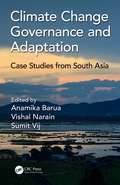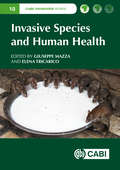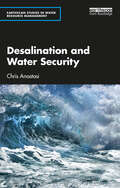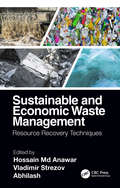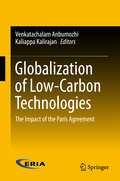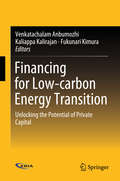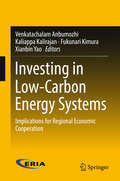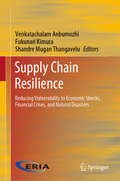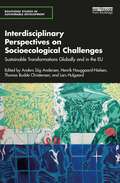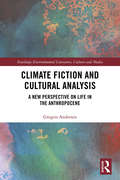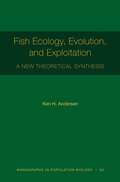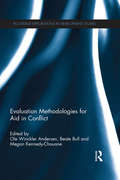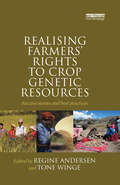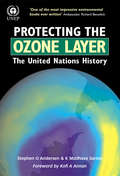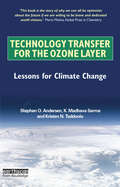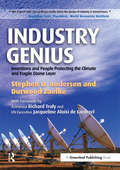- Table View
- List View
Poems for Stillness (Macmillan Collector's Library #316)
by Ana Sampson and Gaby MorganA stunning anthology of poetry to create calm and peacefulness. The poems are arranged around themes of meditation, friendship, gratitude, prayers and blessings, stillness and consolation. Part of the Macmillan Collector’s Library; a series of stunning, pocket-sized classics with ribbon markers. These beautiful books make perfect gifts or a treat for any book lover. This edition features a preface by Ana Sampson. There are poems by Emily Dickinson, William Shakespeare, W. B. Yeats, Katherine Mansfield, George Herbert, William Wordsworth, Anne Brontë, Khalil Gibran, Rumi, Walt Whitman and many more. There are also uplifting prayers and blessings from around the world. Each inspiring verse flows effortlessly into the next in this anthology of classic poetry, Poems for Stillness.
Climate Change Governance and Adaptation: Case Studies from South Asia
by Anamika Barua, Vishal Narain and Sumit VijClimate change adaptation in South Asia is redefining the roles of different actors in the governance processes. The existing governance lack capacity, knowledge, and leadership skills to manage the uncertainties and challenges posed by climate change. This book aims to explain how the governance of climate change adaptation and mitigation is being shaped in the region and how climate change is impacting upon the governance of natural resources. Although the focus is on South Asia, the editors draw a wide range of contributions from northern and southern communities and across various agro-ecological contexts. Climate Change Governance and Adaptation: Case Studies from South Asia sees the changing climate not only as an environmental problem but as a societal challenge and discusses the governance challenges from an interdisciplinary social science perspective across different levels: local, state, and national. Discusses also the challenges and opportunities for increasing the resilience of the society through effective governance around climate change. A top down approach to govern climate change adaptation may not yield desired outcomes; instead the book emphasizes the need to integrate issues of equity, into climate governance and polices. The lessons learned from different cases across South Asia help readers have a better and deeper understanding of the relationships between governance and climate change. Given the diversity of themes covered, this book will appeal not only to researchers and practitioners in the climate change community, but also to those with a broader interest in governance processes.
Invasive Species and Human Health
by Pedro M. Anastácio Leonardo Ancillotto Sylvie Augustin Daniela Boccolini Giuseppe Brundu Dario Capizzi Lucilla Carnevali Marco Di Luca Franz Essl Bella Galil Piero Genovesi Giulio Grandi Lorenzo Lazzaro Antonella Lugliè Angeliki F. Martinou Jolyon M. Medlock Mattia Menchetti Andrea Monaco Emiliano Mori Wolfgang Nentwig Nikola Pantchev Bachisio Mario Padedda Olivier S.G. Pauwels Cristina Preda Petr Pyšek Wolfgang Rabitsch Julian Reynolds Roberto Romi Alain Roques Helen E. Roy Marie-Anne Auger-Rozenberg Riccardo Scalera Francis Schaffner Stefan Schindler Francesco Severini Sauro Simoni Catherine Souty-Grosset Paolo Sposimo Diederik Strubbe Luciano TomaInvasive alien plants and animals are known for their disruption of ecosystems and threat to biodiversity. This book highlights their major impact on human health. This includes not only direct effects through contact with the species via bites, wounds and disease, but also indirect effects caused by changes induced in ecosystems by invasive species, such as more water hyacinth increasing mosquito levels and thereby the potential for malaria. Covering a wide range of case studies from different taxa (animals and plants), and giving an overview of the diverse impacts of invasive species on health in developed and developing countries, the book is a significant contribution that will help in prioritizing approaches to controlling invasive species and mitigating their health effects. It covers invasive plants, marine species, spiders and other arachnids, ticks and dust mites, insects, mosquitos and other diptera, freshwater species (invertebrates and fishes), amphibians and reptiles, birds and mammals. Key Features Collects together the major health impacts for the first time Covers animal and plant invasive species Examines issues in developed and developing countries The broad spectrum of the analyzed case studies will ensure the appeal of the book to a wide public, including researchers of biological invasions, doctors, policy-makers and managers, and students of invasive species in ecology, animal and plant biology and public health medicine.
Desalination and Water Security (Earthscan Studies in Water Resource Management)
by Chris AnastasiDesalination is to the water industry what renewables are to the electricity sector. However, unlike renewables, the former is being deployed in a quiet revolution away from public glare. This book provides a holistic view of desalination, highlighting the important role this technology can play in providing safe access to water across the globe. It describes the context for this technology to flourish in the coming decades. It discusses the pressures on freshwater resources and the key role the desalination industry plays as it moves from a good-to-have provider today to a must-have mainstream water solution in the future. The book explores the vital elements of the desalination industry, including the winning technologies and how further technological developments will reduce costs and increase deployment into new areas. It also addresses the energy used and the key environmental issues of carbon dioxide emissions and brine waste production. Using a series of country case studies, the book illustrates how desalination can supplement natural water resources in different environments and for different purposes, and how it is supporting domestic and economic activity. Providing a forward-thinking assessment, the book considers developments over the next 30 years as climate change impacts become even more apparent. This book will be of great interest to those working to alleviate water scarcity and improve water security. It will also be of interest to those in water resource management, water policy and regulation, water science, and environmental engineering.
Desalination and Water Security (Earthscan Studies in Water Resource Management)
by Chris AnastasiDesalination is to the water industry what renewables are to the electricity sector. However, unlike renewables, the former is being deployed in a quiet revolution away from public glare. This book provides a holistic view of desalination, highlighting the important role this technology can play in providing safe access to water across the globe. It describes the context for this technology to flourish in the coming decades. It discusses the pressures on freshwater resources and the key role the desalination industry plays as it moves from a good-to-have provider today to a must-have mainstream water solution in the future. The book explores the vital elements of the desalination industry, including the winning technologies and how further technological developments will reduce costs and increase deployment into new areas. It also addresses the energy used and the key environmental issues of carbon dioxide emissions and brine waste production. Using a series of country case studies, the book illustrates how desalination can supplement natural water resources in different environments and for different purposes, and how it is supporting domestic and economic activity. Providing a forward-thinking assessment, the book considers developments over the next 30 years as climate change impacts become even more apparent. This book will be of great interest to those working to alleviate water scarcity and improve water security. It will also be of interest to those in water resource management, water policy and regulation, water science, and environmental engineering.
Sustainable and Economic Waste Management: Resource Recovery Techniques
by Hossain Anawar Vladimir Strezov AbhilashThis book compiles research findings directly related to sustainable and economic waste management and resource recovery. Mining wastes and municipal, urban, domestic, industrial and agricultural wastes and effluents—which contain persistent organic contaminants, nanoparticle organic chemicals, nutrients, energy, organic materials, heavy metal, rare earth elements, iron, steel, bauxite, coal and other valuable materials—are significantly responsible for environmental contamination. These low-tenor raw materials, if recycled, can significantly address the demand–supply chain mismatch and process sustainability as a whole while simultaneously decreasing their impacts on human life and biodiversity. This book summarises the large volume of current research in the realm of waste management and resource recovery, which has led to innovation and commercialisation of sustainable and economic waste management for improved environmental safety and improved economics. Key Features: Reviews the key research findings related to sustainable and economic resource recovery and waste management techniques Discusses minimizing waste materials and environmental contaminants with a focus on recovering valuable resources from wastes Examines the potential uses of mining waste in the re-extraction of metals, provision of fuel for power plants, and as a supply of other valuable materials for utilisation/processing Presents research on recycling of municipal, urban, domestic, industrial and agricultural wastes and wastewater in the production and recovery of energy, biogas, fertilizers, organic materials and nutrients Outlines topical research interests resulting in patents and inventions for sustainable and economic waste management techniques and environmental safety
Sustainable and Economic Waste Management: Resource Recovery Techniques
by Hossain Anawar Vladimir Strezov AbhilashThis book compiles research findings directly related to sustainable and economic waste management and resource recovery. Mining wastes and municipal, urban, domestic, industrial and agricultural wastes and effluents—which contain persistent organic contaminants, nanoparticle organic chemicals, nutrients, energy, organic materials, heavy metal, rare earth elements, iron, steel, bauxite, coal and other valuable materials—are significantly responsible for environmental contamination. These low-tenor raw materials, if recycled, can significantly address the demand–supply chain mismatch and process sustainability as a whole while simultaneously decreasing their impacts on human life and biodiversity. This book summarises the large volume of current research in the realm of waste management and resource recovery, which has led to innovation and commercialisation of sustainable and economic waste management for improved environmental safety and improved economics. Key Features: Reviews the key research findings related to sustainable and economic resource recovery and waste management techniques Discusses minimizing waste materials and environmental contaminants with a focus on recovering valuable resources from wastes Examines the potential uses of mining waste in the re-extraction of metals, provision of fuel for power plants, and as a supply of other valuable materials for utilisation/processing Presents research on recycling of municipal, urban, domestic, industrial and agricultural wastes and wastewater in the production and recovery of energy, biogas, fertilizers, organic materials and nutrients Outlines topical research interests resulting in patents and inventions for sustainable and economic waste management techniques and environmental safety
Globalization of Low-Carbon Technologies: The Impact of the Paris Agreement
by Venkatachalam Anbumozhi Kaliappa KalirajanThis book explores the opportunities and barriers within the Intended Nationally Determined Contributions (INDC) framework of the Paris Agreement for low-carbon technology diffusion. Further, it proposes appropriate and feasible mechanisms required at local, national and regional levels to achieve the INDC targets. The book employs both meta policy analysis and scenario building to examine, whether the diffusion of low-carbon energy future by 2030 is economically viable under the INDC framework and how international technology cooperation could accelerate investments on the scale required for achieving the INDC targets.Further, this book provides new perspectives on market and non-market mechanisms for the globalization of low-carbon technologies, within the framework conditions of the Paris Agreement, which will be of significant value to senior policy makers, multi-disciplinary academia, and investing communities.
Financing for Low-carbon Energy Transition: Unlocking the Potential of Private Capital
by Venkatachalam Anbumozhi Kaliappa Kalirajan Fukunari KimuraThis book is the first comprehensive assessment of the state of low-carbon investments in Asia, analyzing the rationales, mandates and public–private financing activities. Based on the experiences of several regional initiatives wherein public financing is catalyzing private investments in low-carbon infrastructure, this book proposes a framework that can be used as a tool to identify factors that influence private investment decisions and policy instruments that can scale up the private capital.Placing the Asian economies onto a low-carbon development pathway requires an unprecedented shift in investments. This book addresses this situation by asking questions such as: • What is the central role of private finance in achieving the Paris Agreement targets? • What key policy levers and risk mitigation can governments use in an effort to unlock the potentials of private capital? • How can regionally coordinated actions hold significant promise for scaling up private investments?
Investing in Low-Carbon Energy Systems: Implications for Regional Economic Cooperation
by Venkatachalam Anbumozhi Kaliappa Kalirajan Fukunari Kimura Xianbin YaoThis book focuses on multi-level actions that have attracted considerable interest and discussion within academia, decision makers and the public as a tool to assess anthropogenic effects of low-carbon energy development. The book begins with an overview of the state of the art policies in emerging economies, which provides a starting point for understanding the concept of low-carbon green growth. A unified framework for structuring, categorizing, and integrating various regional-level actions is established on the basis of a thorough investigation into the theoretical and methodological aspects of non-conventional energy policies that have been widely adopted. Furthermore, the book brings clarity to the relationship between clean energy policies and stakeholder participation, and the significance of coordinated actions at the regional level. The findings provide novel insights and policy tools to help decision-makers in identifying ways to mobilize private investment in low-carbon energy systems.
Supply Chain Resilience: Reducing Vulnerability to Economic Shocks, Financial Crises, and Natural Disasters
by Venkatachalam Anbumozhi Fukunari Kimura Shandre Mugan ThangaveluThis book investigates individual companies’ and industries’ supply chain risk management approaches to identify risk drivers and verify effective risk-reduction measures and business continuity plans.Typically, supply chain risk assessments focus on normative guidelines based on single best practice examples or vulnerability events, and there has been little work exploring how the concepts of supply chain risk management and resilience are related. However, since this relationship has implications for developing integrated response strategies, a clear understanding of the possible consequences is a fundamental step in building socio-economic resilience along the supply chain.Against this background, the book addresses three main topics: firstly, it defines the conceptual and sectoral domains of supply chain risk management and resilience by examining the welfare effects of extreme weather events and other economic shocks on selected global supply chains. It then presents an in-depth analysis of the scope of public–private partnerships to tackle the risks, by empirically exploring supply chain risk effects and information management. Thirdly, it proposes a regional cooperation framework in the context of major supply chain vulnerability events such as disasters and global financial crises.
Interdisciplinary Perspectives on Socioecological Challenges: Sustainable Transformations Globally and in the EU (Routledge Studies in Sustainable Development)
by Anders Siig Andersen Henrik Hauggaard-Nielsen Thomas Budde Christensen Lars HulgaardThis book explores interdisciplinary perspectives on socioecological challenges and offers innovative solutions at both a European and global level. This book critically reflects on the latest scientific knowledge regarding the increasing instability of the Earth System caused by human activities during the Anthropocene and the Great Acceleration. It focuses on the global and European challenges regarding climate, resources, bio-integrity, and environment. The authors assess the obstacles to overcoming these challenges and examine the risks posed by path dependencies, lock-ins, and trade-offs between global and regional goals. They also drill down into the complexities of the European Green Deal, specifically the similarities and differences between the scientific analyses and recommendations from the European Environment Agency and the content of the Deal. Finally, the book looks at the Just Transition put forward by the European Green Deal. The authors discuss this in a context of global and European ecological and socioecological challenges and put the question of equality, recognition, and democratization at the center. Outlining new pathways to broaden the scope of scientific collaboration between the natural and technical sciences and the social sciences and the humanities, this volume will be of great interest to students and scholars of sustainable development, environmental policy and governance, and environmental justice.
Interdisciplinary Perspectives on Socioecological Challenges: Sustainable Transformations Globally and in the EU (Routledge Studies in Sustainable Development)
by Anders Siig Andersen Henrik Hauggaard-Nielsen Thomas Budde Christensen Lars HulgaardThis book explores interdisciplinary perspectives on socioecological challenges and offers innovative solutions at both a European and global level. This book critically reflects on the latest scientific knowledge regarding the increasing instability of the Earth System caused by human activities during the Anthropocene and the Great Acceleration. It focuses on the global and European challenges regarding climate, resources, bio-integrity, and environment. The authors assess the obstacles to overcoming these challenges and examine the risks posed by path dependencies, lock-ins, and trade-offs between global and regional goals. They also drill down into the complexities of the European Green Deal, specifically the similarities and differences between the scientific analyses and recommendations from the European Environment Agency and the content of the Deal. Finally, the book looks at the Just Transition put forward by the European Green Deal. The authors discuss this in a context of global and European ecological and socioecological challenges and put the question of equality, recognition, and democratization at the center. Outlining new pathways to broaden the scope of scientific collaboration between the natural and technical sciences and the social sciences and the humanities, this volume will be of great interest to students and scholars of sustainable development, environmental policy and governance, and environmental justice.
Climate Fiction and Cultural Analysis: A new perspective on life in the anthropocene (Routledge Environmental Literature, Culture and Media)
by Gregers AndersenClimate Fiction and Cultural Analysis argues that the popularity of the term "climate fiction" has paradoxically exhausted the term’s descriptive power and that it has developed into a black box containing all kinds of fictions which depict climatic events and has consequently lost its true significance. Aware of the prospect of ecological collapse as well as our apparent inability to avert it, we face geophysical changes of drastic proportions that severely challenge our ability to imagine the consequences. This book argues that this crisis of imagination can be partly relieved by climate fiction, which may help us comprehend the potential impact of the crisis we are facing. Strictly assigning "climate fiction" to fictions that incorporate the climatological paradigm of anthropogenic global warming into their plots, this book sets out to salvage the term’s speculative quality. It argues that climate fiction should be regarded as no less than a vital supplement to climate science, because climate fiction makes visible and conceivable future modes of existence within worlds not only deemed likely by science, but which are scientifically anticipated. Focusing primarily on English and German language fictions, Climate Fiction and Cultural Analysis shows how Western climate fiction sketches various affective and cognitive relations to the world in its utilization of a small number of recurring imaginaries, or imagination forms. This book will be of great interest to students and scholars of ecocriticism, the environmental humanities, and literary and culture studies more generally.
Climate Fiction and Cultural Analysis: A new perspective on life in the anthropocene (Routledge Environmental Literature, Culture and Media)
by Gregers AndersenClimate Fiction and Cultural Analysis argues that the popularity of the term "climate fiction" has paradoxically exhausted the term’s descriptive power and that it has developed into a black box containing all kinds of fictions which depict climatic events and has consequently lost its true significance. Aware of the prospect of ecological collapse as well as our apparent inability to avert it, we face geophysical changes of drastic proportions that severely challenge our ability to imagine the consequences. This book argues that this crisis of imagination can be partly relieved by climate fiction, which may help us comprehend the potential impact of the crisis we are facing. Strictly assigning "climate fiction" to fictions that incorporate the climatological paradigm of anthropogenic global warming into their plots, this book sets out to salvage the term’s speculative quality. It argues that climate fiction should be regarded as no less than a vital supplement to climate science, because climate fiction makes visible and conceivable future modes of existence within worlds not only deemed likely by science, but which are scientifically anticipated. Focusing primarily on English and German language fictions, Climate Fiction and Cultural Analysis shows how Western climate fiction sketches various affective and cognitive relations to the world in its utilization of a small number of recurring imaginaries, or imagination forms. This book will be of great interest to students and scholars of ecocriticism, the environmental humanities, and literary and culture studies more generally.
Fish Ecology, Evolution, and Exploitation: A New Theoretical Synthesis (Monographs in Population Biology #93)
by Ken H. AndersenFish are one of the most important global food sources, supplying a significant share of the world’s protein consumption. From stocks of wild Alaskan salmon and North Sea cod to entire fish communities with myriad species, fisheries require careful management to ensure that stocks remain productive, and mathematical models are essential tools for doing so. Fish Ecology, Evolution, and Exploitation is an authoritative introduction to the modern size- and trait-based approach to fish populations and communities.Ken Andersen covers the theoretical foundations, mathematical formulations, and real-world applications of this powerful new modeling method, which is grounded in the latest ecological theory and population biology. He begins with fundamental assumptions on the level of individuals and goes on to cover population demography and fisheries impact assessments. He shows how size- and trait-based models shed new light on familiar fisheries concepts such as maximum sustainable yield and fisheries selectivity—insights that classic age-based theory can’t provide—and develops novel evolutionary impacts of fishing. Andersen extends the theory to entire fish communities and uses it to support the ecosystem approach to fisheries management, and forges critical links between trait-based methods and evolutionary ecology.Accessible to ecologists with a basic quantitative background, this incisive book unifies the thinking in ecology and fisheries science and is an indispensable reference for anyone seeking to apply size- and trait-based models to fish demography, fisheries impact assessments, and fish evolutionary ecology.
Evaluation Methodologies for Aid in Conflict (Routledge Explorations in Development Studies)
by Ole Winckler Andersen Beate Bull Megan Kennedy-ChouaneKnowledge and rigorous evidence around the role of external development partners in situations of conflict and fragility is still lacking. There is little accountability for the billions in aid being spent in places like Afghanistan, Iraq and the Democratic Republic of Congo. This book analyses evaluation theory and practice in order to help fill this knowledge gap and advocates a realistic and rigorous approach to evaluating international engagement. Through a series of case studies, this book highlights both the promise, and potential pitfalls, of taking a more evaluative approach to understanding aid in conflict regions. These illustrate the methodological and analytical approach taken by researchers working to understand the results and effectiveness of conflict prevention and peacebuilding support. While well-grounded in current theoretical and methodological debates, the book provides valuable practical information by examining how and why different choices were made in the context of each evaluation. The book shows what future steps may be envisaged to further strengthen evaluations of support for conflict prevention and peacebuilding. The analysis draws on a wealth of perspectives and voices to provide researchers and students in development studies and conflict and peace studies as well as development evaluators with a deep and broad understanding of evaluation methods and approaches.
Evaluation Methodologies for Aid in Conflict (Routledge Explorations in Development Studies)
by Ole Winckler Andersen Beate Bull Megan Kennedy-ChouaneKnowledge and rigorous evidence around the role of external development partners in situations of conflict and fragility is still lacking. There is little accountability for the billions in aid being spent in places like Afghanistan, Iraq and the Democratic Republic of Congo. This book analyses evaluation theory and practice in order to help fill this knowledge gap and advocates a realistic and rigorous approach to evaluating international engagement. Through a series of case studies, this book highlights both the promise, and potential pitfalls, of taking a more evaluative approach to understanding aid in conflict regions. These illustrate the methodological and analytical approach taken by researchers working to understand the results and effectiveness of conflict prevention and peacebuilding support. While well-grounded in current theoretical and methodological debates, the book provides valuable practical information by examining how and why different choices were made in the context of each evaluation. The book shows what future steps may be envisaged to further strengthen evaluations of support for conflict prevention and peacebuilding. The analysis draws on a wealth of perspectives and voices to provide researchers and students in development studies and conflict and peace studies as well as development evaluators with a deep and broad understanding of evaluation methods and approaches.
Realising Farmers' Rights To Crop Genetic Resources: Success Stories And Best Practices
by Regine Andersen Tone WingeFarmers' rights are essential for maintaining crop genetic diversity, which is the basis of all food and agricultural production in the world. The International Treaty on Plant Genetic Resources for Food and Agriculture recognizes Farmers' rights and provides for relevant measures. However, implementation is slow, and in many countries there is resistance. This book shows the necessity of realizing Farmers' rights for poverty alleviation and food security, the practical possibilities of doing so, and the potential gains for development and society at large. It provides decision-makers and practitioners with a conceptual framework for understanding Farmers' rights and success stories showing how each of the elements of Farmers' rights can be realized in practice. Such success stories have brought substantial achievements as regards one or more of the four elements of Farmers' rights: the rights of farmers to save, use, exchange and sell farm-saved seed; the protection of traditional knowledge; benefit- sharing; and participation in decision-making. These examples are not perfect, but challenges encountered on the way also offer important lessons. They represent different regions and localities, including Europe, Asia, Africa and Latin America, as well as various categories of stakeholders and types of initiatives and policies.
Realising Farmers' Rights To Crop Genetic Resources: Success Stories And Best Practices (PDF)
by Regine Andersen Tone WingeFarmers' rights are essential for maintaining crop genetic diversity, which is the basis of all food and agricultural production in the world. The International Treaty on Plant Genetic Resources for Food and Agriculture recognizes Farmers' rights and provides for relevant measures. However, implementation is slow, and in many countries there is resistance. This book shows the necessity of realizing Farmers' rights for poverty alleviation and food security, the practical possibilities of doing so, and the potential gains for development and society at large. It provides decision-makers and practitioners with a conceptual framework for understanding Farmers' rights and success stories showing how each of the elements of Farmers' rights can be realized in practice. Such success stories have brought substantial achievements as regards one or more of the four elements of Farmers' rights: the rights of farmers to save, use, exchange and sell farm-saved seed; the protection of traditional knowledge; benefit- sharing; and participation in decision-making. These examples are not perfect, but challenges encountered on the way also offer important lessons. They represent different regions and localities, including Europe, Asia, Africa and Latin America, as well as various categories of stakeholders and types of initiatives and policies.
Protecting the Ozone Layer: The United Nations History
by Stephen O Andersen K Madhava SarmaIn the 1970s the world became aware of a huge danger: the destruction of the stratospheric ozone layer by CFCs escaping into the atmosphere, and the damage this could do to human health and the food chain. So great was the threat that by 1987 the UN had succeeded in coordinating an international treaty to phase out emissions; which, over the following 15 years has been implemented. It has been hailed as an outstanding success. It needed the participation of all the parties: governments, industry, scientists, campaigners, NGOs and the media, and is a model for future treaties. This volume provides the authoritative and comprehensive history of the whole process from the earliest warning signs to the present. It is an invaluable record for all those involved and a necessary reference for future negotiations to a wide range of scholars, students and professionals.
Protecting the Ozone Layer: The United Nations History
by Stephen O Andersen K Madhava SarmaIn the 1970s the world became aware of a huge danger: the destruction of the stratospheric ozone layer by CFCs escaping into the atmosphere, and the damage this could do to human health and the food chain. So great was the threat that by 1987 the UN had succeeded in coordinating an international treaty to phase out emissions; which, over the following 15 years has been implemented. It has been hailed as an outstanding success. It needed the participation of all the parties: governments, industry, scientists, campaigners, NGOs and the media, and is a model for future treaties. This volume provides the authoritative and comprehensive history of the whole process from the earliest warning signs to the present. It is an invaluable record for all those involved and a necessary reference for future negotiations to a wide range of scholars, students and professionals.
Technology Transfer for the Ozone Layer: Lessons for Climate Change
by Stephen O. Andersen K. Madhava Sarma Kristen N. Taddonio'Imagine the pride of earning the Nobel Prize for warning that CFCs were destroying the ozone layer. Then imagine that citizens, policymakers, and business executives heeded the warning and transformed markets to protect the earth. This book is the story of why we can all be optimistic about the future if we are willing to be brave and dedicated world citizens.' MARIO MOLINA, Nobel Laureate in Chemistry and Professor, University of California This book tells how the Montreal Protocol, the most successful global environmental agreement so far, stimulated the development and worldwide transfer of technologies to protect the ozone layer.Technology transfer is the crux of the 230 international environmental treaties and is essential to fighting climate change. While debate rages about obstacles to technology transfer, until now there has been no comprehensive assessment of what actually works to remove the obstacles. The authors, leaders in the field, assess over 1000 technology transfer projects funded under the Montreal Protocol?s Multilateral Fund and the Global Environment Facility, and identify lessons that can be applied to technology transfer for climate change.
Technology Transfer for the Ozone Layer: Lessons for Climate Change
by Stephen O. Andersen K. Madhava Sarma Kristen N. Taddonio'Imagine the pride of earning the Nobel Prize for warning that CFCs were destroying the ozone layer. Then imagine that citizens, policymakers, and business executives heeded the warning and transformed markets to protect the earth. This book is the story of why we can all be optimistic about the future if we are willing to be brave and dedicated world citizens.' MARIO MOLINA, Nobel Laureate in Chemistry and Professor, University of California This book tells how the Montreal Protocol, the most successful global environmental agreement so far, stimulated the development and worldwide transfer of technologies to protect the ozone layer.Technology transfer is the crux of the 230 international environmental treaties and is essential to fighting climate change. While debate rages about obstacles to technology transfer, until now there has been no comprehensive assessment of what actually works to remove the obstacles. The authors, leaders in the field, assess over 1000 technology transfer projects funded under the Montreal Protocol?s Multilateral Fund and the Global Environment Facility, and identify lessons that can be applied to technology transfer for climate change.
Industry Genius: Inventions and People Protecting the Climate and Fragile Ozone Layer
by Stephen Andersen Durwood ZaelkeThis book presents the inventive genius behind technological breakthroughs by ten global companies including Alcoa, DaimlerChrysler, Honda, ST Micro and Visteon. Readers will gain understanding and insight into how cutting-edge technology is helping protect the climate and/or the ozone layer, while contributing to the company's bottom line. Each chapter chronicles the challenge and triumph of invention, introduces the engineers and executives who overcome conventional wisdom, and demonstrates the contribution these companies are making to environmental protection. In full colour and crammed with graphics to illustrate the creative process of technological breakthroughs, the book is accessible and informative. The genius of these ten companies will inspire the engineer, the policy-maker, the student, the environmentalist, the CEO and the investor alike.

